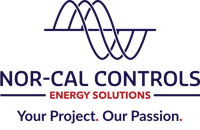In a solar PV Data Acquisition System (DAS), a data logger is typically the device used to concentrate and collect all of the data from the field devices. It then logs that data into a format that can be analyzed. It is an important device for collecting metrics on how a solar PV site is performing. There are four types of data loggers that Nor-Cal often integrates for DAS applications at solar PV sites. In this guide, we will cover the applications, cost, specs, benefits and potential drawbacks of each.
Types of Data Loggers for Solar PV DAS Sites
Red Lion Data Logger
The Red Lion data logger is good for collecting from a smaller number of field devices at a DAS site. At Nor-Cal, we also use it often for MET station applications.
We typically use the Red Lion Graphite® Edge Controller, which costs around $1,300 for the base model. This industrially hardened small form factor data logger can be mounted on a DIN rail in a communication enclosure and has a wide operating temperature range, which means it typically doesn't need ventilation.
The main benefits of the Red Lion data logger are its versatility and flexibility. It has both serial and Ethernet ports to translate between devices, and supports over 300 standard industry protocols. This makes it extremely versatile in terms of all the applications and devices it can communicate with. There are multiple plug-in modules and expansion racks available, providing flexible options for future needs. However, this does mean that you won't have hardwired I/O in a base model. Red Lion also provides its Crimson configuration software to download for free.
The Red Lion data logger does have limitations in terms of how many devices it can talk to. If you try to pull data from too many devices it may slow down the overall throughput, so this should be considered when implementing in a DAS environment.
Campbell Scientific Data Logger
Like Red Lion, the Campbell Scientific data logger is typically used for MET stations and for collecting data from a smaller number of devices in a DAS. It has similar specifications too, in that it is a small form factor data logger that can mount on a DIN rail in a communication enclosure. It has both Ethernet and serial connectivity.
The main benefit of the Campbell Scientific is the built-in hard-wired inputs and outputs on the base unit. This feature is extremely helpful if you are trying to interface with devices where analog voltages or currents need to be measured. For example, many MET station sensors have that capability and some MET sensors only have that capability. The Campbell Scientific data logger is also highly efficient in terms of memory management and how it logs data with its power usage in general.
The main drawback is the cost. The Campbell Scientific is the most expensive data logger on this list. You can expect to pay $1,500 for the base model, but the greater cost comes from the LoggerNet configuration software at $600–$700 per download. You can get by without the software, but you wouldn't want to as you need it to get the most out of your data logger.
Windows/PC-Based Data Logger
A Windows/PC-based data logger can handle many more connections than the Red Lion or Campbell Scientific, so we tend to use this type on larger DAS sites. The cost can range from $700–$1,000 depending on the configuration. A PC data logger is bigger than the Red Lion or Campbell, but is still capable of mounting inside a communication enclosure. It has good connectivity as well, with both serial and Ethernet ports.
The main benefit of this type of data logger is customizability; you can configure it to the functionality you need for the site. You can change the amount of processing power depending on how much you think you'll need for the site, or what kind of software you're running on it. There is hard drive storage for data logging capability, so you can actually run full historian software on the Windows PC if you need to. You can put almost any software you want on it, since a Windows PC is very versatile when it comes to applications.
PC-based data loggers have much more horsepower and storage than the other options. The corresponding downside to its customizability is that it takes much more effort to set up. You have to go through the process of installing and setting up the data logger software on the PC. It also has less efficient power consumption, which is important to keep in mind for battery backups.
Obvius AcquiSuite Data Logger
Like the Red Lion and Campbell Scientific, the Obvius AcquiSuite data logger is good for MET stations and smaller depth sites. It is similar to the Red Lion in specs in that it is industrially hardened, has a small form factor, as has both serial and Ethernet ports.
The specific Obvius AcquiSuite data logger model we typically work with is the A8810. It is the most cost effective data logger on this list at about $600—half the cost of the other two data loggers that are geared for smaller sites. Another benefit is that it's self-contained, making it less cumbersome to set up than some other data loggers. There’s no extra software required; you use a web interface to set it up.
This simplicity does mean that there are limitations in terms of functionality. The A8810 doesn't have much in the way of local/onsite logging capability. It is primarily meant to push data to a cloud-based platform, making it more of a gateway than a data logger compared to the others.
Nor-Cal can set you up with the best data logger for your DAS.
All of the data logger options covered here are versatile, good quality, reliable, and can work well in the right DAS setup. It's all a matter of the functionality you need at your solar PV site and often comes down to your own preference.
At Nor-Cal, we have worked with each of these data loggers and can recommend the best model for your requirements. If you have a data logger in mind you want to use, we will make it work. We won't limit you to a proprietary system, hardware or software.
Schedule a call with us today.





